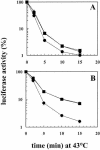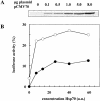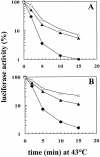Cycloheximide- and puromycin-induced heat resistance: different effects on cytoplasmic and nuclear luciferases
- PMID: 11005376
- PMCID: PMC312884
- DOI: 10.1379/1466-1268(2000)005<0181:capihr>2.0.co;2
Cycloheximide- and puromycin-induced heat resistance: different effects on cytoplasmic and nuclear luciferases
Abstract
Inhibition of translation can result in cytoprotection against heat shock. The mechanism of this protection has remained elusive so far. Here, the thermoprotective effects of the translation inhibitor cycloheximide (CHX) and puromycin were investigated, using as reporter firefly luciferase localized either in the nucleus or in the cytoplasm. A short preincubation of O23 cells with either translation inhibitor was found to attenuate the heat inactivation of a luciferase directed into the cytoplasm, whereas the heat sensitivity of a nuclear-targeted luciferase remained unaffected. After a long-term CHX pretreatment, both luciferases were more heat resistant. Both the cytoplasmic and the nuclear luciferase are protected against heat-induced inactivation in thermotolerant cells and in cells overexpressing heat shock protein (Hsp)70. CHX incubations further attenuated cytoplasmic luciferase inactivation in thermotolerant and in Hsp70 overexpressing cells, even when Hsp70-mediated protection was saturated. It is concluded that protection by translation inhibition is unlikely due to an increase in the pool of free Hsps normally engaged in translation and released from the nascent polypeptide chains on the ribosomes. Rather, a decrease in nascent chains and thermolabile polypeptides may account for the heat resistance promoted by inhibitors of translation.
Figures







Similar articles
-
In vivo chaperone activity of heat shock protein 70 and thermotolerance.Mol Cell Biol. 1999 Mar;19(3):2069-79. doi: 10.1128/MCB.19.3.2069. Mol Cell Biol. 1999. PMID: 10022894 Free PMC article.
-
Stress dose-dependent suppression of heat shock protein gene expression by inhibiting protein synthesis during heat shock treatment.Cell Struct Funct. 1997 Feb;22(1):7-13. doi: 10.1247/csf.22.7. Cell Struct Funct. 1997. PMID: 9113384
-
Effect of cycloheximide or puromycin on induction of thermotolerance by heat in Chinese hamster ovary cells: dose fractionation at 45.5 degrees C1.Cancer Res. 1987 Nov 15;47(22):5960-6. Cancer Res. 1987. PMID: 3664499
-
Suppression of thermotolerance development through cycloheximide-induced negative control of stress protein gene expression.J Biochem. 1998 Feb;123(2):226-32. doi: 10.1093/oxfordjournals.jbchem.a021926. J Biochem. 1998. PMID: 9538196
-
Protection of Chinese hamster ovary cells from heat killing by treatment with cycloheximide or puromycin: involvement of HSPs?Radiat Res. 1987 Aug;111(2):237-53. Radiat Res. 1987. PMID: 3628714
Cited by
-
The mechanism whereby heat shock induces apoptosis depends on the innate sensitivity of cells to stress.Cell Stress Chaperones. 2010 Jan;15(1):101-13. doi: 10.1007/s12192-009-0126-9. Epub 2009 Jun 26. Cell Stress Chaperones. 2010. PMID: 19557548 Free PMC article.
-
Transcriptional firing helps to drive NETosis.Sci Rep. 2017 Feb 8;7:41749. doi: 10.1038/srep41749. Sci Rep. 2017. PMID: 28176807 Free PMC article.
References
-
- Angelidis CE, Lazaridis I, Pagoulatos GN. Constitutive expression of heat-shock protein 70 in mammalian cells confers thermoresistance. Eur J Biochem. 1991;199:35–39. - PubMed
-
- Armour EP, Lee YJ, Corry PM, Borrelli MJ. Protection from heat-induced protein migration and DNA repair inhibition by cycloheximide. Biochem Biophys Res Commun. 1988;157:611–617. - PubMed
-
- Beckmann RP, Mizzen LA, Welch WJ. Interaction of Hsp70 with newly synthesized proteins: implications for protein folding and assembly. Science. 1990;248:850–854. - PubMed
-
- Borrelli MJ, Stafford DM, Rausch CM, Lepock JR, Lee YJ, Corry PM. Reduction of levels of nuclear-associated protein in heated cells by cycloheximide, D2O, and thermotolerance. Radiat Res. 1992;131:204–213. - PubMed
Publication types
MeSH terms
Substances
LinkOut - more resources
Full Text Sources
